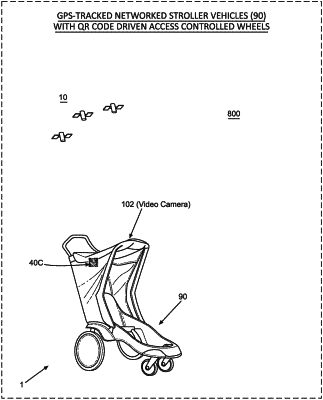| CPC G07F 17/12 (2013.01) [G06K 7/1417 (2013.01); G06Q 30/0645 (2013.01); G07C 9/00309 (2013.01); G07C 9/00571 (2013.01); G07C 9/00912 (2013.01); G07C 2009/00523 (2013.01)] | 16 Claims |

|
1. A method of providing device-level access control to a wireless-networked stroller using a web-enabled mobile phone to scan a device-level machine-readable code posted on each of a plurality of wireless-networked strollers available for selection, rental, access and usage within an environment involving the wireless transmission and reception of radio signals between said wireless-networked stroller and a wireless access control system, said method comprising the steps of:
(a) using a web-enabled mobile phone deployed on and operably connected to a wireless communication infrastructure, and for scanning of a device-level machine-readable code posted on a wireless-networked stroller selected for rental, access and usage in said environment,
wherein said wireless-networked stroller includes a stroller framework for carrying a passenger, and having at least a set of wheels mounted on an axle provided with a wheel braking assembly;
a hand-actuated control bar assembly mounted on said wireless-networked stroller by way of mounting brackets attached to said stroller framework, and
wherein said hand-actuated control bar assembly including a user-operated handle fixed to a first rod member slidably connected with a second rod member that is terminated in a brake foot portion adapted for engaging with said wheel brake assembly during brake locking operations;
a wireless wheel-axle control module operably connected to said hand-actuated control bar assembly, and adapted for wireless transmission and reception of radio signals between said wireless-networked stroller and said wireless access control system;
said wireless wheel-axle control module having a battery-operated motor controllable in a locked state of operation and in an unlocked state of operation;
wherein when said battery-operated motor is controlled in said locked state of operation, said user-operated handle is locked stationary relative to said second rod member, while said brake foot portion engages with and locks said wheel braking assembly so that said stroller framework cannot move freely on a support surface; and
wherein when said battery-operated motor is controlled in said unlocked state of operation, a user is prevented from pushing said user-operated handle downward and causing said wheel braking assembly to move into a locking position, so that said wheels are unlocked and free to rotate without resistance, and said stroller framework can move freely on said support surface;
(b) when said web-enabled mobile phone scans said device-level machine-readable code displayed on said wireless-networked stroller, a stroller rental transaction is completed over said wireless access control system, and the user obtains access control over said rented wireless-networked stroller supported by wireless radio signal and transmission between said wireless-networked stroller and said wireless access control system, then said wireless wheel-axle control module enables said unlocked state of operation, in which said set of wheels are allowed to rotate and said stroller framework is allowed to move freely on said support surface; and
(c) when the user uses said web-enabled mobile phone to terminate said stroller rental transaction over said wireless access control system, and returns access control over said rented wireless-networked stroller, then said wireless wheel-axle control module enables said locked state of operation, in which said set of wheels are prevented from rotation and said stroller framework is not allowed to move freely on said support surface.
|